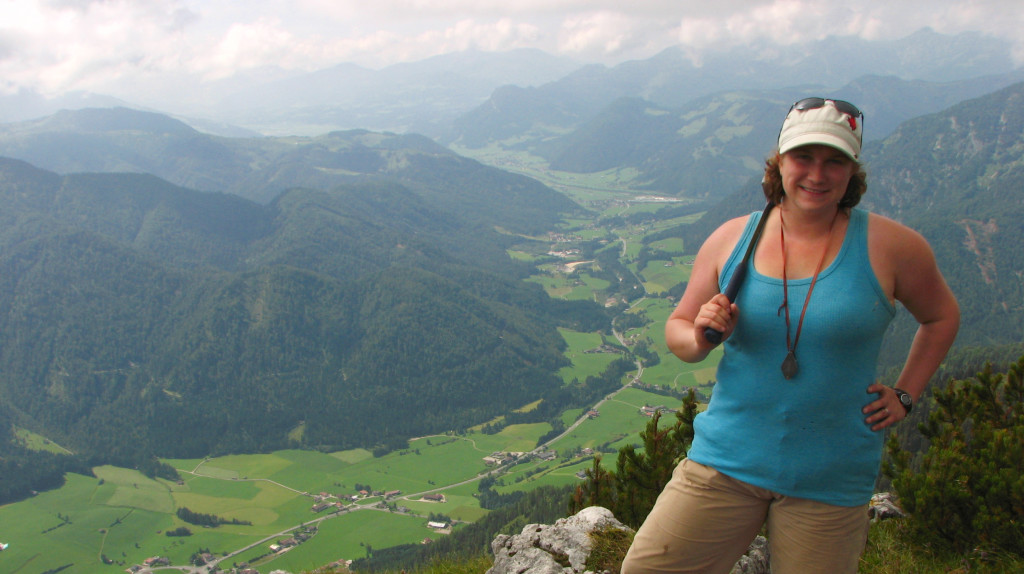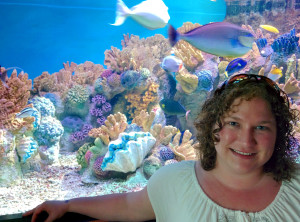
PhD from University of Southern California, BS from Queen’s University
Field sites past & present: Italy, Austria, Germany, Slovenia, Australia, Canada (Alberta and British Columbia), USA (Nevada and Oregon)
It is common knowledge that burning fossil fuels (oil, natural gas, coal) adds carbon dioxide (CO2) to the atmosphere. All scientists and a steadily increasing proportion of non-scientists also know that CO2 is a greenhouse gas, which means that increasing the amount of CO2 in the atmosphere will cause temperature to rise. And thus we have GLOBAL CLIMATE CHANGE, which has been widely publicized and (regrettably) politicized. Unfortunately, global climate change is not the only misfortune of our CO2 emissions. CO2 does not remain in the atmosphere for all eternity – it has to go somewhere, and one major somewhere is the ocean. Adding CO2 to water makes it more acidic, and voila, OCEAN ACIDIFICATION, global warming’s popularly neglected, ugly stepsister. So why care if the ocean is getting more acidic? Well, many of your favorite marine critters (corals, clams, snails) have external hard parts made of calcium carbonate, which dissolves in acid. Even minor changes in the ocean pH (e.g. 8.2 to 8.0) can cause problems with skeleton building, growth, reproduction, or survival, especially when coupled with warmer temperatures. Get it? Got it? Eek!
Dr. Rowan Martindale scours the fossil record for past examples of ocean acidification and its effect on reef ecosystems, particularly the corals themselves. Her dissertation research focused on the Late Triassic (235 – 201 million years ago), when the ancestors of the creatures that make up our modern reefs were just gaining prominence. Rowan investigated reef composition and ecology to understand how these reefs worked, and she also compared reefs from different parts of North America and Austria to document geographic differences in reef composition, diversity, and structure. Rowan’s knowledge of Late Triassic reefs is especially important because the Triassic-Jurassic boundary is one of the five largest mass extinctions in Earth’s history and included widespread reef collapse.
At the end of the Triassic, a huge amount of magma quickly (by geologic standards) erupted, splitting the supercontinent Pangea and creating what is now the Atlantic Ocean. The volcanic province covered an area larger than the United States or Canada and released lots of CO2, SO2, and other nasty gases into the atmosphere and ocean. Analyses from plant fossils and soil carbonates at the T-J boundary provide an independent line of evidence for increased CO2. Using a range of interdisciplinary studies from geology to climatology to modern reef ecology, Rowan and her colleagues have concluded that oceanic acidification was likely a major player in the T-J extinction. Rowan has now moved on to studying another reef extinction event in the Early Jurassic (~183 million years ago) that coincides with large volcanic eruptions across South Africa and Antarctica. She and her colleagues seek to determine whether ocean acidification also played a role in this event, which produced a less severe extinction. By comparing and contrasting this extinction and reef collapse with the T-J event, Rowan hopes to determine what factors allow organisms to survive a major climate perturbation event.
In keeping with the field theme of the blog, I asked Rowan to share one of her favorite field stories, and it’s a good one:
“Before I went to Austria (PhD work), I consulted one of the great Austrian paleontologists Dr. Alfred Fischer who was an emeritus faculty at USC. Al is a legend and even in his late 80s still had a photographic memory of field sites he’d only been to once in his 20s/30s. Unfortunately due to his age, Al couldn’t join me in the Alps, but he gave me directions to several great sites (some of which were just ‘up the hill, to the left a-ways’….. which turned out to be a 3-5 km hike up a kilometer of elevation). While I was doing research on the Late Triassic Steinplatte reef near Tyrol, Austria, my field assistant and I found that the Austrians had built numerous billboards on the mountain to explain the paleontology that one might encounter during your hike (e.g. under your feet is the Rosso Ammonitico, a red limestone with fossils of ancient nautilus-like organisms). We hiked up the mountain (all the while thinking what an awesome idea this was), and when we reached the top, where the best corals were supposed to be, low and behold there was a big billboard about Fischer’s coral reef! I couldn’t believe it…. even though he was sitting at home in San Pedro, CA, Al had managed to join me in Austria! We took a bunch of photos and tried to read all the German descriptions of the fabulous corals that were at our feet and then brought them back for Al to see his enduring influence.”
I am seriously jealous that no such billboards exist for the paleobotanical sites of Roland Brown, Harry MacGinitie, Leo Hickey, and Scott Wing that I’ve visited in Western North America!
For more information on Dr. Rowan Martindale, visit her professional website here or UT’s profile of her.
